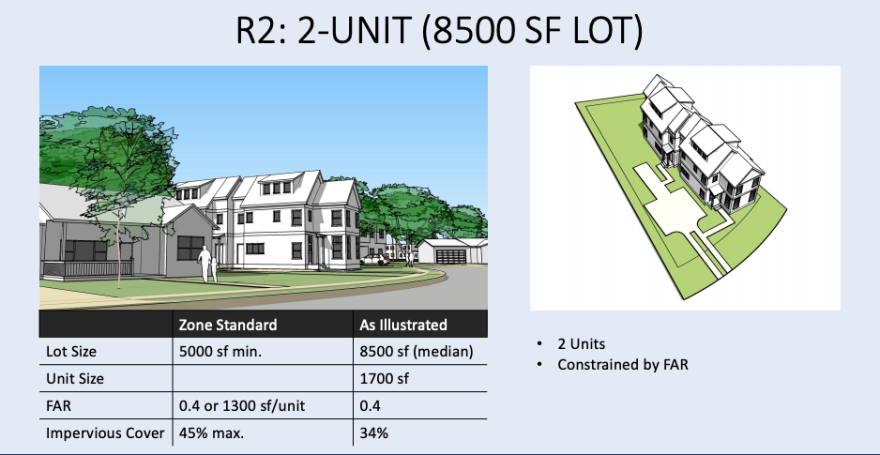The City of Austin on Wednesday revealed some models of what could be built under the proposed new land development code, the rules that dictate what can be built in the city and where.
It’s important to note that in most cases the images show the maximum of what could be built. Developers could decide to build fewer units and smaller homes, or the specifics of a certain piece of land could make it hard to build the maximum number.
In the models below, R stands for residential and the number following it generally indicates the total number of homes that could be built. For example, R3 stands for a residential zone where a developer could build up to three homes.
If the land you live on is zoned R2
Under the latest draft of the new code, roughly 21% of the city would be zoned R2. If your land is zoned R2 and you have a 5,000-square-foot lot (which is considered small), you could build one 2,000-square-foot house.

If you wanted to build two homes on that 5,000-square-foot lot, each home would have to be a bit smaller. That’s illustrated below:

If you want bigger homes, you’ll likely need a bigger lot. In this case, the city has modeled two 1,700-square-foot homes below:

If the land you live on is zoned R3
A very small portion of the city – about 0.2% – is proposed to be zoned R3. The median square footage of these affected lots is just over 7,000 square feet, and below you can see that you might get three 1,000-square-foot homes on a piece of land that size:

The city has proposed a program to encourage older homes not be demolished. If you own a home that’s 30 years or older, you can build more on your land as long as you don’t knock down that home. Here’s what that could look like in an R3 zone:

If the land you live on is zoned R4
Only 1.5% of the city is proposed to be under the new R4 zone. If that includes where you live, here’s what new development could look like. You’d get a fourplex with roughly 1,000-square-foot homes.

Under this zoning category, you can build up to eight units if you agree to either put money into the city’s affordable housing coffers or build the affordable housing yourself. In parts of the city susceptible to gentrification, the developer would not have the option to pay the fee and would have to build the affordable housing. If those four additional houses get built, you’d get eight slightly smaller homes.

If the land you live on is zoned RM1
This zone is also rare (comprising about 1% of the city), but could be found in some neighborhoods. Here's what six housing units could look like on a smaller lot, or 5,000 square feet:

This zone also includes an option that allows a developer to build more units in exchange for building affordable housing or putting money toward it. The developer could build up to 10 units if it agrees to the affordable housing bonus; but again, that doesn’t mean affordable housing would be built on this plot of land.

There are more models drawn up by the city, including for much larger, commercial and mixed-use properties. You can see all the renderings by scrolling to the end of the document below:
Got a tip? Email Audrey at audrey@kut.org. Follow her on Twitter @AKMcGlinchy.
If you found the reporting above valuable, please consider making a donation to support it. Your gift pays for everything you find on KUT.org. Thanks for donating today.






